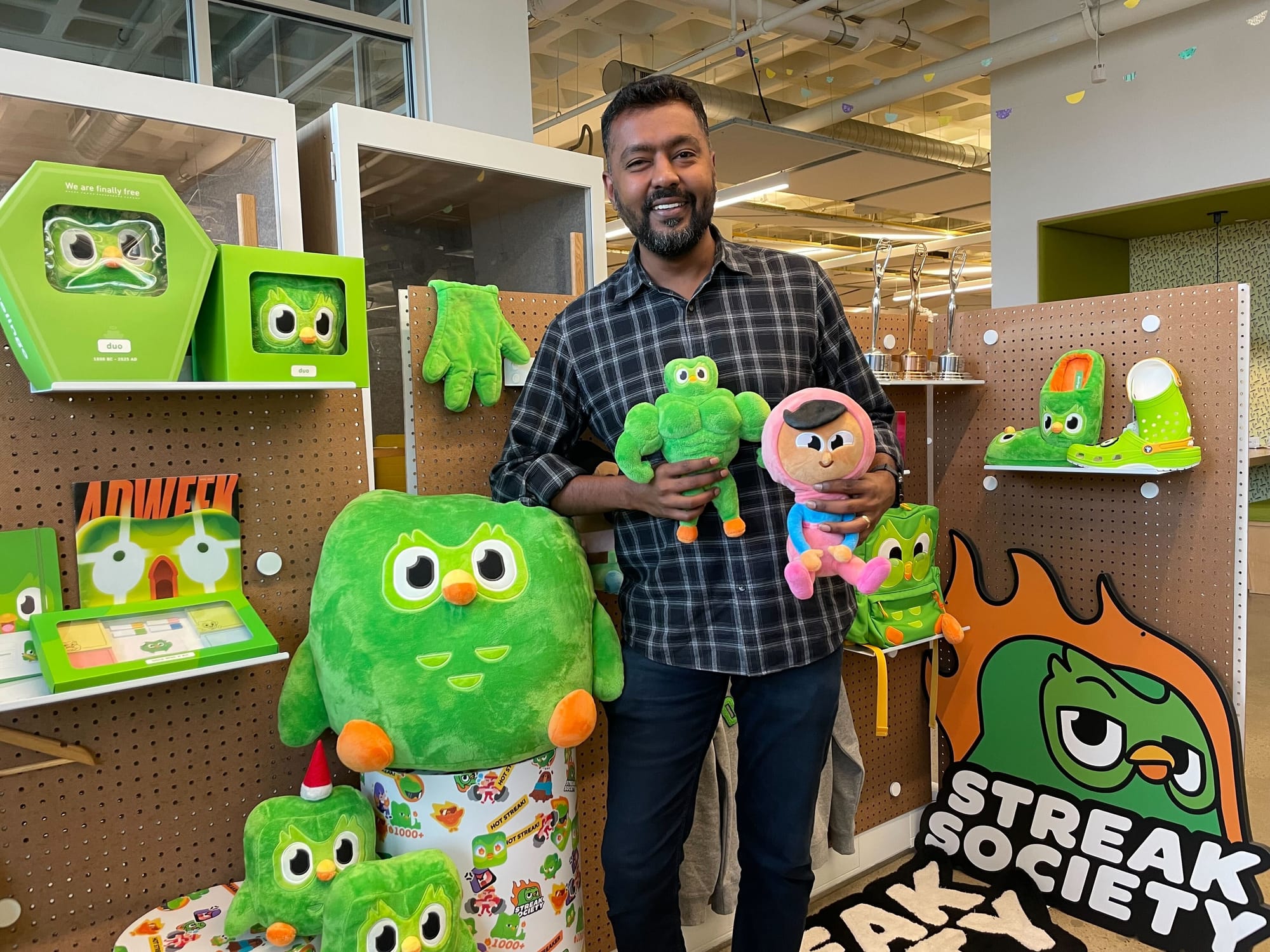I’m Anand, a Senior Engineering Director. Before joining, I knew Duolingo as a language-learning app, but I didn’t realize it was headquartered in Pittsburgh. After more than a decade in big tech hubs, I thought I had seen most versions of engineering leadership. But this past year has been one of the most unique and rewarding chapters of my career.
When I joined Duolingo a year ago, I carried three questions that reflected both my curiosity and my doubts.
- Why did interviews for people managers include a pair programming round? After years of leading engineering teams, I wasn’t expecting to be asked to code in an interview, so what did that say about the culture here?
- What would life in Pittsburgh actually be like? After more than a decade in Seattle and San Francisco, I wondered how uprooting my family to a new city I’d never considered would feel.
- What would leadership look like in a company where onboarding leaders can take more than six months? In every company I’d worked at before, leaders were expected to make an immediate impact.
Twelve months in, I’d like to share some reflections: the doubts I brought with me, the surprises I encountered, and the perspective I’ve gained along the way.

Why does Duolingo use pair programming to interview engineering leaders?
First impressions: I was skeptical. Why would an engineering leader spend part of their interview loop pair programming? It felt unusual and maybe even unnecessary.
One year later: It turned out to be one of the smartest differentiators in our process. Leaders here are expected to be able to operate at any level, not because they’ll be writing code every day, but because they need to coach, teach, and empathize with engineers at every stage of their careers. Pair programming shows whether you can do that. It’s less about syntax and more about mindset.
In my own interview, the goal wasn’t the “perfect” solution. It was about how I explained my thinking and adapted to feedback. That mirrored exactly what leadership looks like at Duolingo: listening, coaching, and collaborating. Looking back, I see why it’s such a powerful filter for culture fit.
What is it like to move from the Bay Area to Pittsburgh for Duolingo?
First impressions: When I first told my wife about interviewing at Duolingo and the possibility of moving to Pittsburgh, she was, as always, enthusiastic. Her immediate response was, “Now you’ll see Niagara Falls!” Meanwhile, I wondered what life outside the Bay would really be like.
One year later: My first season here was winter 😄. It was a shock compared to what I was used to, but with the right layers and some local advice, I got through it. Since then, the changing seasons have won me over!
Pittsburgh itself has been a wonderful surprise. It’s a charming, European-feeling city with rich architecture, a deep culture of education and learning, caring neighbors, and a vibrant network of mom-and-pop businesses. Yes, it really does have 446 bridges, and I plan to cross them all!
Most importantly, the people really make the place. At Duolingo, I’ve made many wonderful friends. Outside of work, neighbors have shown the same warmth and generosity, always ready with recommendations or a helping hand. That sense of community has been a wonderful surprise.
If you've ever been hesitant about moving for a job in a city you've never considered, especially Pittsburgh, look closer. You might end up loving the path less traveled!
Why does onboarding leaders take more than 6 months here?
First impressions: I started as an engineer on the team I’d later lead. A month in, I would become the team lead supporting ~10 people. After 4 months, I would be an area lead supporting ~70 people and eventually a pillar lead supporting ~150 people. Early on, I was still figuring out what “great” looked like in my role, and I worried at times whether I was making an impact quickly enough. I also had to be proactive in my onboarding since Duolingo was still evolving its approach for senior leaders.
Note: Duolingo uses a matrixed organizational structure. Team members belong to both a function (like Engineering or Design) and a pillar (like Growth or Learning). Each pillar is made up of areas, and within each area, there are teams focused on specific goals.
One year later: The philosophy of Taking the Long View helped. During my listening tour, a senior product leader told me: “At most companies, leaders need to show impact immediately because the average tenure is short. At Duolingo, we expect leaders to be here for a long time, so 3–6 months of onboarding is not a big deal.” That reframed things: onboarding isn’t about waiting. It’s about practicing patience in the right way, by moving quickly on what builds trust, context, and small wins.
I built trust not through big bets, but by starting with curiosity, spotting opportunities, delivering small wins, and then scaling up. Diving into technical and operational details helped my ideas carry weight with the team. Those insights turned into tangible changes that boosted morale, velocity, and impact. Later, when I moved into a new area with different challenges, I used the same approach: listen, identify opportunities, show progress. That consistency signaled reliability and adaptability.
Progressing from team → area → pillar lead gave me empathy for each layer of leadership. In a recent reorg, I made choices that considered the overhead area leads would face, something I wouldn’t have appreciated without walking that path myself. Walking in others’ shoes builds empathy, and empathy builds better leadership decisions. Even when you don’t fully understand another perspective, taking the time to consider it can multiply your impact.
What it takes to thrive at Duolingo
Looking back, the way I ramped up and the culture I’ve experienced highlight certain qualities that matter most at Duolingo. If you’re considering joining, these are the ones that will help you thrive here:
- Embody Duolingo’s operating principles daily.
- Stay curious and keep a growth mindset.
- Be a hands-on leader, focused on learning and impact.
- Communicate concisely and clearly.
- Experiment quickly, bias toward action, and don’t be afraid to ship.
- Jump into every product review – they’re open and transparent to the whole company!
- Build cross-functional relationships early.
- Learn from teammates beyond your own function, from our brilliant Learning & Curriculum team to our talented artists.
Overall reflections after a year
Biggest surprise: The strength of the mission-driven culture and how deeply experimentation is ingrained.
Hardest adjustment: Embracing patience while taking the long view. For me, the most valuable growth came from learning that sustainable leadership impact comes less from quick wins and more from trust, empathy, and the humility to dive into details when needed.
Most rewarding: Building trust, growing scope, supporting my teams and the impact they had (e.g., launching new courses and AI powered video call).
For future leaders: Duolingo isn’t for everyone. The bar is high, scope evolves with the business, and leaders are expected to be humble and hands-on. But if you’re mission-driven, curious, and willing to take the long view, it’s a uniquely rewarding place to build a career.
It’s been a busy, fulfilling year and what keeps me inspired every day is our mission: creating the world’s best education and making it universally available.
If this sounds like something that drives you, we’re hiring!
